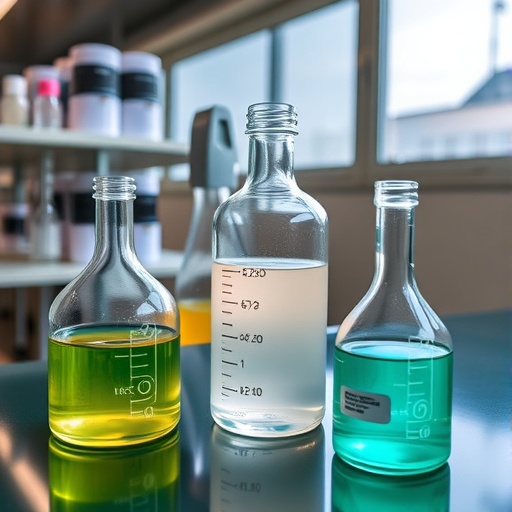In a groundbreaking advancement that could reshape our approach to mitigating climate change, researchers at Paderborn University have unveiled a novel, metal-free catalytic method to decompose nitrous oxide — a notorious greenhouse gas known colloquially as ‘laughing gas’. This innovation not only targets the destruction of nitrous oxide’s detrimental impact on the ozone layer but also operates efficiently at low temperatures, a feat that could revolutionize the practical usability of such catalytic systems in environmental applications.
Nitrous oxide (N₂O) is recognized as one of the most potent anthropogenic greenhouse gases, with a global warming potential approximately 265 times greater than that of carbon dioxide on a 100-year scale. Its contribution to global warming accounts for about six percent of the total radiative forcing from greenhouse gases, a significant figure that underlines the urgent necessity for effective reduction strategies. The increasing concentration of nitrous oxide in the atmosphere — estimated to have risen by over 20 percent since the dawn of the industrial age — reflects ongoing industrial, agricultural, and medical processes, making mitigation both challenging and imperative.
Led by Professor Jan Paradies, the research team has ingeniously designed a catalytic cycle centered on phosphetane compounds, which serve as the key agents in the oxygen transfer reaction that reduces nitrous oxide. The catalyst’s action involves a reductive cleavage of the nitrogen-oxygen bonds within N₂O, thereby liberating nitrogen gas (N₂), an inert and environmentally benign molecule. This transformation effectively neutralizes nitrous oxide’s capacity to damage the ozone and trap heat within the atmosphere.
A particularly remarkable feature of this catalysis is its metal-free nature. Unlike traditional catalysts that often rely on rare or heavy metals, which can pose supply, cost, and toxicity concerns, the phosphetane catalyst circumvents these issues. This lowers the environmental footprint of the catalysis itself and enhances the scalability potential for real-world application. Importantly, the catalytic process unfolds efficiently at relatively low temperatures, which implies reduced energy consumption and the possibility of integration into existing emission control frameworks without excessive infrastructural overhaul.
The underlying chemistry hinges on the interaction between nitrous oxide and the phosphetane catalyst, which abstracts oxygen atoms from N₂O to form a stable phosphetane-oxygen intermediate. This intermediate can then revert to its original catalytic form upon treatment with a silane – a compound characterized by silicon-hydrogen bonds. The silane essentially reduces the phosphetane-oxygen species, completing the catalytic cycle and enabling continuous operation. This regenerative process signifies a key advance, as it prevents the catalyst from being consumed or deactivated, ensuring extended functionality and cost-effectiveness.
Beyond the immediate reduction of nitrous oxide, the generation of molecular nitrogen (N₂) holds agricultural promise. Nitrogen gas, often converted further through industrial processes such as the Haber-Bosch method, forms the backbone of synthetic fertilizer production. By deploying this novel catalytic system in agricultural or industrial setups, it may be possible not only to curb greenhouse gas emissions but also to recover useful feedstock, marrying environmental protection with economic benefit.
The implications for climate science and environmental policy are profound. Current methods for nitrous oxide abatement, including thermal decomposition and catalytic reduction typically require high temperatures and metal catalysts, which are energy-intensive and sometimes environmentally problematic. The Paderborn team’s approach promises a more sustainable and economically viable alternative, potentially enabling widespread adoption and substantial emission reductions.
This pioneering research embodies a broader shift in chemical innovation aimed at addressing environmental crises through more intelligent, efficient, and sustainable catalysis. By championing non-metal catalysis and harnessing subtle molecular transformations, scientists can devise solutions that reduce dependency on scarce materials and minimize secondary pollution. Such strategies are poised to become central pillars in the global response to climate change.
The study, recently published in the eminent Journal of the American Chemical Society, brings together an interdisciplinary team of scholars including doctoral researchers Rundong Zhou and Viktorija Medvaric alongside Professors Thomas Werner and Jan Paradies. Their collective efforts illustrate how fundamental chemical insights can lead to practical technologies with global impact.
Moreover, this method sets the foundation for potential future innovations in the capture and conversion of other environmentally damaging molecules. By demonstrating the feasibility of low-temperature, metal-free catalytic cycles in gas-phase reduction reactions, this research opens new horizons in green chemistry and catalytic engineering.
The full technical elucidation of the catalyst’s structure and reaction mechanism shines light on the subtle electronic and steric factors that govern its activity, underscoring the precision required in designing next-generation catalysts. Computational studies complement experimental data, revealing that the specific phosphetane ring strain and electron density distribution play crucial roles in facilitating oxygen transfer from nitrous oxide.
In summary, this breakthrough not only advances the chemistry of greenhouse gas reduction but also exemplifies a visionary pathway towards integrating catalysis in the fight against climate change. With continued development and scaling, such innovative catalytic systems may soon become indispensable tools in global efforts to preserve the ozone layer and curb atmospheric warming.
Subject of Research: Development of a metal-free, low-temperature catalytic system for the reduction of nitrous oxide greenhouse gas
Article Title: Metal-Free Catalysis for the Decomposition of Nitrous Oxide at Low Temperatures Using Phosphetane Catalysts
Web References: http://dx.doi.org/10.1021/jacs.5c06190
References: Published in the Journal of the American Chemical Society
Keywords: Nitrous Oxide Reduction, Metal-Free Catalysis, Greenhouse Gas Mitigation, Phosphetane Catalysts, Low-Temperature Catalysis, Ozone Depletion, Climate Change, Sustainable Chemistry, Catalytic Cycle




